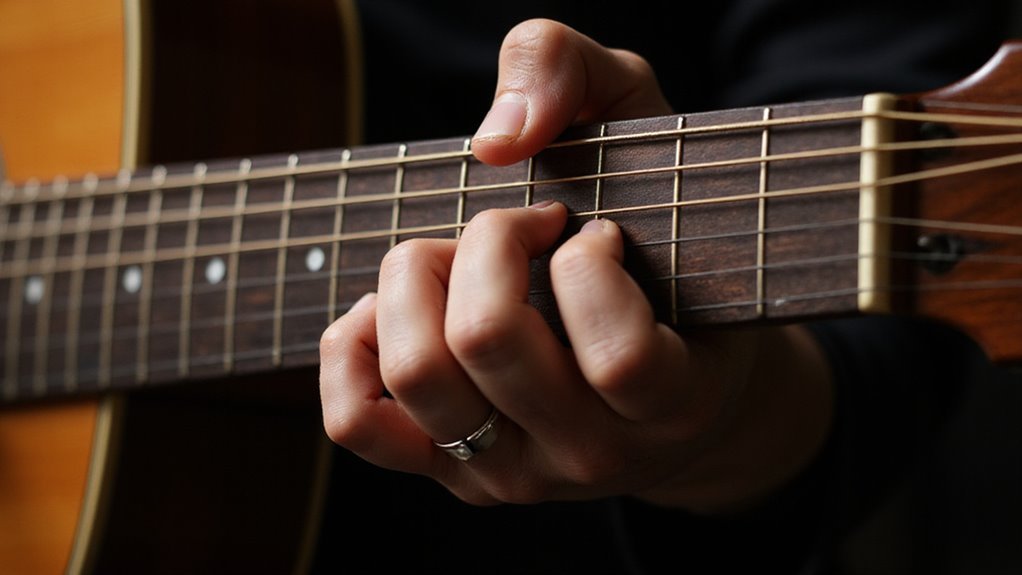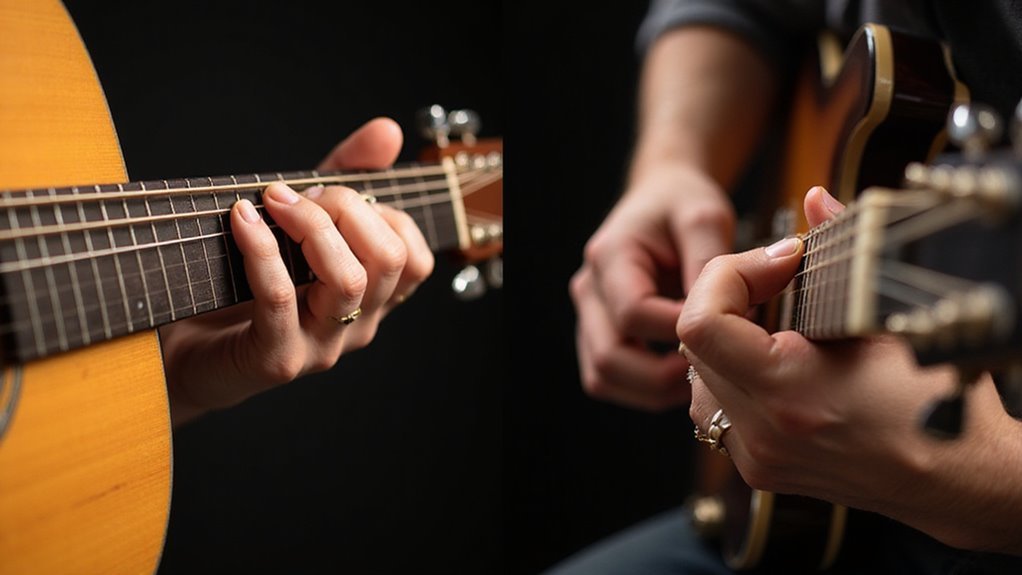Did you know that nearly 70% of beginner guitarists quit within the first year, with barre chords often cited as a major frustration point? If you’ve ever pressed your index finger across all six strings of an acoustic guitar only to hear buzzing and muted notes, you’re not alone. I’ve spent countless hours helping students overcome this hurdle, and I think the difference between giving up and breaking through often comes down to understanding why these chord formations feel so challenging in the first place.
Why Barre Chords Feel Harder on Acoustic Guitars

When you first attempt barre chords on an acoustic guitar, you’ll immediately notice they require considerably more finger strength than on an electric. This isn’t just in your head – it’s physics! The higher string action and increased tension on acoustics demand greater pressure from your fretting hand.
Many players (myself included) find this initially discouraging. You’re not alone if your hand cramps up after just a few minutes of practice.
I think the wider neck profile of most acoustics adds another layer of difficulty too, requiring your fingers to stretch further.
But persevere – mastering barre chords on acoustic will make electric feel like a breeze!
Essential Mechanics and Theory Behind Barre Chord Formation

Although barre chords might seem intimidating at first, understanding the mechanics behind them reveals they’re fundamentally movable patterns that access the entire fretboard.
You’re basically creating a new “nut” with your index finger, allowing open chord shapes to be played anywhere on the neck.
The beauty of barre chords is that they follow consistent patterns. Once you’ve mastered the E and A shape barres, you’ve revealed hundreds of chord variations.
The true power of barre chords lies in their simplicity—master two shapes and unlock an entire universe of musical possibilities.
Your barring finger must apply even pressure across all strings—this is perhaps the trickiest part that most guitarists struggle with initially.
Comparing Acoustic vs. Electric Guitar Barre Chord Playability

Despite sharing fundamental chord shapes, the experience of playing barre chords differs dramatically between acoustic and electric guitars. You’ll notice right away that electrics offer a more forgiving approach with their lighter string tension and lower action. This means your fingers won’t have to work quite as hard to press down all those strings cleanly.
Acoustic guitars, I think, demand more from you physically. Their higher tension and typically wider necks require greater hand strength and precision.
But don’t get discouraged! There’s something incredibly satisfying about nailing a clear, resonant barre chord on an acoustic. Perhaps that’s why mastering them first creates such a solid foundation for your playing journey.
Proven Practice Techniques for Mastering Barre Chords
Mastering barre chords requires consistent, targeted practice—there’s simply no shortcut around it.
I think the most effective approach is breaking down your practice into manageable chunks. Try 10-15 minute sessions where you focus solely on barring technique before your hands fatigue.
Start with finger strength exercises like “finger push-ups” against a table. Then practice applying even pressure across all strings with your index finger. Perhaps the most helpful tip is positioning your thumb correctly—it should rest halfway down the neck, providing counter-pressure.
Use a metronome when shifting between shapes. Remember, we’re all struggling with barre chords initially!
Common Mistakes and Professional Setup Solutions
When you’re struggling with barre chords, you’re likely making one of several common errors that plague most beginners. The most frequent mistake is applying uneven pressure with your index finger, causing those frustrating buzzing strings.
Your thumb position also matters—it should act as a counterbalance behind the neck, not hanging over the top.
Perhaps the biggest game-changer might be getting a professional setup for your acoustic guitar. A qualified technician can lower the action and suggest lighter strings that’ll make those barre shapes feel less like torture devices.
Trust me, I think this small investment is worth every penny when you’re trying to join the ranks of confident barre chord players.
Frequently Asked Questions
How Long Does It Take to Master Barre Chords Completely?
You’ll master barre chords in 2-6 months with daily practice. Your progress depends on your dedication, finger strength, and technique. Don’t rush—everyone’s learning journey differs.
Can Smaller Hands Succeed With Barre Chords on Acoustic Guitars?
Like a sparrow building its nest, you can absolutely succeed with barre chords despite smaller hands. You’ll need proper technique, targeted exercises, and a well-setup guitar to join your fellow acoustic players.
Do Certain Guitar Brands Offer Easier Barre Chord Experiences?
Yes, guitars from Taylor, Ibanez, and PRS often feature slimmer necks and lower action that’ll make your barre chord journey easier. You’ll find these brands accommodate smaller hands wonderfully.
Are Partial Barre Chords Acceptable Alternatives for Beginners?
Yes, partial barre chords are perfect alternatives when you’re starting out. They’ll build your strength gradually while letting you make music right away. Everyone uses them, even pros!
How Do Capos Affect Barre Chord Difficulty and Sound Quality?
Capos reduce barre chord difficulty by effectively shortening the neck, letting you play with open chord shapes. They’ll maintain sound quality while requiring less finger strength for your progressions.
Conclusion
You’re on a tough but rewarding path with acoustic barre chords. Like climbing a musical mountain, the journey requires patience and persistence. Don’t be discouraged by initial hand fatigue or buzzing notes—these are temporary hurdles. With consistent practice and proper technique, your fingers will eventually dance across those strings with confidence. Remember, the strength you’re building now will pay dividends whether you stick with acoustic or venture into electric territory.